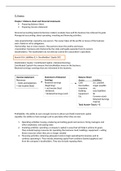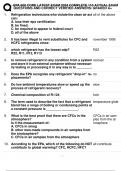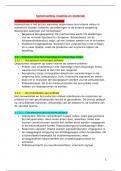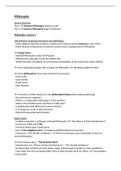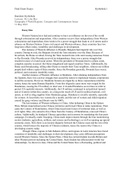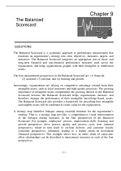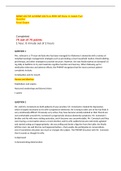Week 1
Function of financial markets
It channels funds from person or business without investment opportunities (lender) to one
who has them (borrower). It goes from primary investors (households) who want high
liquidity, low risk and small amount, to ultimate borrowers (businesses) who have low
liquidity, high risk and large amounts projects. This brings high search, agreement and
monitoring costs
Structure of financial markets
- Debt markets
o Short-term (maturity < 1 year)
o Long-term (maturity > 10 year)
o Intermediate term (maturity in between)
- Equity markets
o Pay dividends, in theory forever
o Represents an ownership claim in the firm
- Primary market
o New security issues sold to initial buyers
o Typically involves an investment bank who underwrites the offering
- Secondary market
o Securities previously issued are bought and sold
o Examples include the NYSE and Nasdaq
o Involves both brokers and dealers
o Important for the primary market
- Exchanges
o Trades conducted in central locations (e.g., New York Stock Exchange, CBOT)
- Over-the-counter markets
o Dealers at different locations buy and sell
o Best example is the market of treasury securities
- Money market: short term (maturity < 1 year)
- Capital market: long-term (maturity > 1 year) + equities
Internationalization of Financial Markets
The internationalization of markets is an important trend. The U.S. no longer dominates the
world stage. International Bond Market & Eurobonds:
- Foreign bonds: Denominated in a foreign currency and targeted at a foreign market
- Eurobonds: Denominated in one currency, but sold in a different market. Now larger than
U.S. corporate bond market. Over 80% of new bonds are Eurobonds
- Eurocurrency market: Foreign currency deposited outside of home country. Eurodollars
are U.S. dollars deposited in, say, London. Gives U.S. borrowers an alternative source for
dollars
Direct versus Indirect Finance
- Direct Finance: Borrowers borrow directly from lenders in financial markets by selling
financial instruments which are claims on the borrower’s future income or assets
- Indirect Finance: Borrowers borrow indirectly from lenders via financial intermediaries
(established to source both loanable funds and loan opportunities) by issuing financial
instruments which are claims on the borrower’s future income or assets
, Function of financial intermediaries
Indirect Finance
The intermediary obtains funds from savers and then makes loans/investments with
borrowers. This process, called financial intermediation, is actually the primary means of
moving funds from lenders to borrowers. More important source of finance than securities
markets (such as stocks). It is needed because of transactions costs, risk sharing, and
asymmetric information
Transaction Costs
A financial intermediary’s low transaction costs mean that it can provide its customers with
liquidity services, services that make it easier for customers to conduct transactions
- Banks provide depositors with checking accounts that enable them to pay their bills easily
- Depositors can earn interest on checking and savings accounts and yet still convert them
into goods and services whenever necessary
Another benefit made possible by the FI’s low transaction costs is that they can help reduce
the exposure of investors to risk, through a process known as risk sharing:
- FIs create and sell assets with lesser risk to one party in order to buy assets with greater
risk from another party (pool assets à diversification)
- This process is referred to as asset transformation, because in a sense risky assets are
turned into safer assets for investors
- Also transforms magnitude and maturity
Adverse Selection
Before transaction occurs. Potential borrowers most likely to produce adverse outcome are
ones most likely to seek a loan
Moral Hazard
After transaction occurs. Hazard that borrower has incentives to engage in undesirable
(immoral) activities making it more likely that won’t pay loan back
Depository Institutions
Such as banks: accept deposits and make loans. These include commercial banks and thrifts
Commercial banks
Raise funds primarily by issuing checkable, savings, and time deposits which are used to make
commercial, consumer and mortgage loans. Collectively, these banks comprise the largest
financial intermediary and have the most diversified asset portfolios
Thrifts
Such as S&Ls & Mutual Savings Banks and Credit Unions. They raise funds primarily by issuing
savings, time, and checkable deposits which are most often used to make mortgage and
Function of financial markets
It channels funds from person or business without investment opportunities (lender) to one
who has them (borrower). It goes from primary investors (households) who want high
liquidity, low risk and small amount, to ultimate borrowers (businesses) who have low
liquidity, high risk and large amounts projects. This brings high search, agreement and
monitoring costs
Structure of financial markets
- Debt markets
o Short-term (maturity < 1 year)
o Long-term (maturity > 10 year)
o Intermediate term (maturity in between)
- Equity markets
o Pay dividends, in theory forever
o Represents an ownership claim in the firm
- Primary market
o New security issues sold to initial buyers
o Typically involves an investment bank who underwrites the offering
- Secondary market
o Securities previously issued are bought and sold
o Examples include the NYSE and Nasdaq
o Involves both brokers and dealers
o Important for the primary market
- Exchanges
o Trades conducted in central locations (e.g., New York Stock Exchange, CBOT)
- Over-the-counter markets
o Dealers at different locations buy and sell
o Best example is the market of treasury securities
- Money market: short term (maturity < 1 year)
- Capital market: long-term (maturity > 1 year) + equities
Internationalization of Financial Markets
The internationalization of markets is an important trend. The U.S. no longer dominates the
world stage. International Bond Market & Eurobonds:
- Foreign bonds: Denominated in a foreign currency and targeted at a foreign market
- Eurobonds: Denominated in one currency, but sold in a different market. Now larger than
U.S. corporate bond market. Over 80% of new bonds are Eurobonds
- Eurocurrency market: Foreign currency deposited outside of home country. Eurodollars
are U.S. dollars deposited in, say, London. Gives U.S. borrowers an alternative source for
dollars
Direct versus Indirect Finance
- Direct Finance: Borrowers borrow directly from lenders in financial markets by selling
financial instruments which are claims on the borrower’s future income or assets
- Indirect Finance: Borrowers borrow indirectly from lenders via financial intermediaries
(established to source both loanable funds and loan opportunities) by issuing financial
instruments which are claims on the borrower’s future income or assets
, Function of financial intermediaries
Indirect Finance
The intermediary obtains funds from savers and then makes loans/investments with
borrowers. This process, called financial intermediation, is actually the primary means of
moving funds from lenders to borrowers. More important source of finance than securities
markets (such as stocks). It is needed because of transactions costs, risk sharing, and
asymmetric information
Transaction Costs
A financial intermediary’s low transaction costs mean that it can provide its customers with
liquidity services, services that make it easier for customers to conduct transactions
- Banks provide depositors with checking accounts that enable them to pay their bills easily
- Depositors can earn interest on checking and savings accounts and yet still convert them
into goods and services whenever necessary
Another benefit made possible by the FI’s low transaction costs is that they can help reduce
the exposure of investors to risk, through a process known as risk sharing:
- FIs create and sell assets with lesser risk to one party in order to buy assets with greater
risk from another party (pool assets à diversification)
- This process is referred to as asset transformation, because in a sense risky assets are
turned into safer assets for investors
- Also transforms magnitude and maturity
Adverse Selection
Before transaction occurs. Potential borrowers most likely to produce adverse outcome are
ones most likely to seek a loan
Moral Hazard
After transaction occurs. Hazard that borrower has incentives to engage in undesirable
(immoral) activities making it more likely that won’t pay loan back
Depository Institutions
Such as banks: accept deposits and make loans. These include commercial banks and thrifts
Commercial banks
Raise funds primarily by issuing checkable, savings, and time deposits which are used to make
commercial, consumer and mortgage loans. Collectively, these banks comprise the largest
financial intermediary and have the most diversified asset portfolios
Thrifts
Such as S&Ls & Mutual Savings Banks and Credit Unions. They raise funds primarily by issuing
savings, time, and checkable deposits which are most often used to make mortgage and



